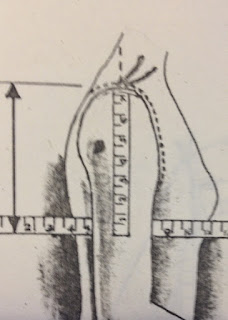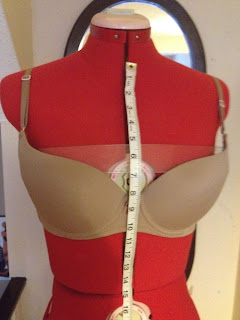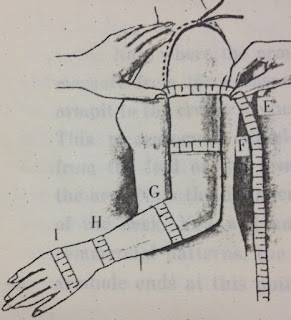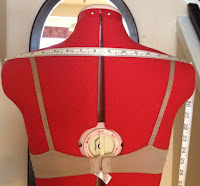Before
making a well fitted garment or an accurate pattern it is important to take accurate
measurements in this tutorial we will outline how to take measurement
that will ensure a perfect fit.
The first step is to have a note book just for measurements and sewing notes. Place it by your sewing machine for reference. If you are taking measurements for yourself it will help if you ask someone to help you. Take as many measurements as possible, in that way you will not have to be taking measurement every time you make an outfit, whether for yourself or someone else.
First you will need a well fitting bra. Avoid pulling the tape too tightly. Also tie piece of elastic around your waist as a guide to emphasize the waist line.

1: Measure around your body below the bust and add 5" to this measurement. (the 5" is for ease)
2: Measure around the fullest part of the bust. Allow 2" for ease. (when taking body measurements always allow 2" for ease)
3: Next you measure back length starting from the nape of neck. To be sure you have the right length from the nape of neck place a ruler between the bra strap as shown on diagram. This will make allowance for rounded shoulder blade.
The bone at the nape of the neck is the largest vertebra at the base of the neck. Place the tape just above the bone, measure down to the waist keeping the tape steady.
4: Front Length - Place the ruler just above the bust as you did when measuring the back. Place tape in the hollow at base of neck and measure down to the waist

5, 6, & 7 - Skirt Length
Place the tape measure at the waist, measure the right side, then the front and the back. (Measure the length you want. ie: Mini, Knee, Midi or Maxi)
8: Length from armpit to waist
 | |
9: Length from the inside shoulder at the neck to the waist, passing over the fullest part of the bust. For a floor length dress measure to the floor, adding 2" for hem. |
10: Lift arm to shoulder
lever and feel for cavity at shoulder tip.
Measure from the base of the
neck to the length of sleeve desired.
A: for sleeveless:
B: for short
sleeve
C: for elbow length or
D: for full length sleeve

For a cap sleeve - Measure the length halfway between the shoulder as shown.
11: Measuring arm, forearm and wrist. Measure largest part of the arm, then around forearm. Then measure around hand below elbow, wrist and hand as indicated in the above diagram.
12:
Across front width - Measure from the crease of the right armpit to the
crease of the left armpit. This measurement is taken from the fold of
the arm, (not under the arm).
13: Across back width:
Fold
arms in a relaxed manner and measure the same as you did the front. It
is important this measurement is accurate as possible, and allow 2"
ease to ensure a smooth back that is not too tight.
14: Follow the bone structure and measure from the tip of one shoulder to the other. If you have rounded shoulders, or have extra muscle or excess flesh in the area make allowance for this when taking measurement.
15: On the diagram you will see four sections.
(1) Is the natural waist line.
(2) Lower waist
(3) Upper hip
(4) Natural hip line.
1: Without pulling the tape too tightly measure the waist at the smallest point.
2: Measure 3" down from the waist. This will give you the lower waist
3: Measure 7" down from the waist . This will give you the upper hip
4: Measure 9" down. That will give you the natural hip line. Measure hips at the largest point
Measure the circumference of all these points, adding 2" for ease allowance.
You can use these measurement when adjusting your patterns. Patterns are just approximations. You can adjust the pattern to your personal measurement ensure a perfect fit.
SOME USEFUL TIPS WHEN BUYING
COMMERCIAL PATTERNS:
Commercial patterns are designed to give ease allowance. A garment designed for work or leisure requires more ease allowance that a dressy garment. ie: A strapless evening dress will have only 1" ease allowance at the bust, but 4" for a blouse. A coat will have considerable more ease allowance because it is worn over clothing.
Heavy or stiff fabrics or fabrics with rough textures do not require as much ease as light, soft or transparent fabrics such as chiffon.
Children clothes will wear much better if they have plenty of ease allowance to withstand children playing.
If you have a slight physical defect, garments should not be fitted tightly. Tight fitting garments will only emphasize the problem.
If you are under 120 lbs add ease to the bust and hips. If you have a sway back give more ease to this area in order to cover the hollow.












Comments
Post a Comment